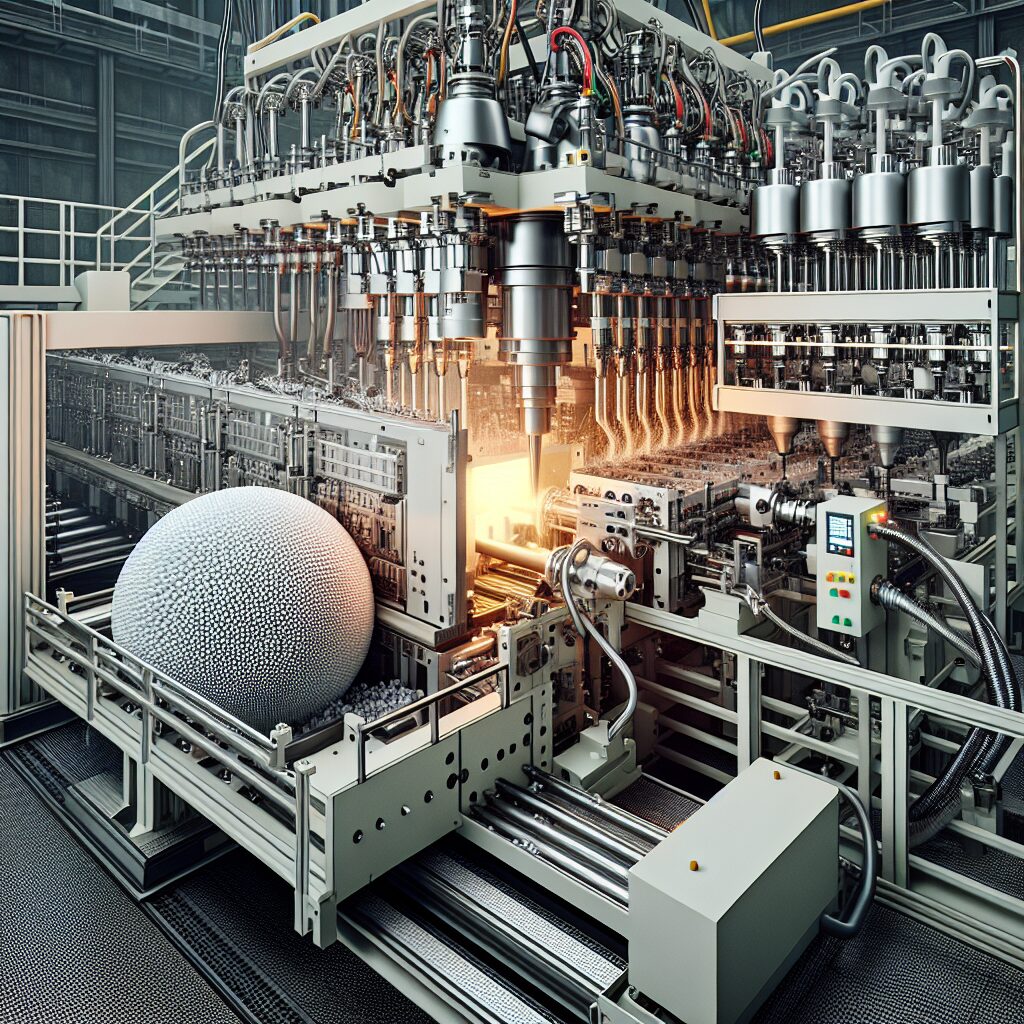Injection molding is a crucial process in ball manufacturing that involves injecting molten material into a mold to create various spherical objects. This method offers numerous advantages such as high production rates, versatility in design, and cost-effectiveness. The ability to quickly and accurately produce uniform, precise, and durable balls makes injection molding an ideal choice for industries ranging from sports equipment manufacturing to automotive components. Furthermore, the use of injection molding allows for the incorporation of complex features and intricate designs, ensuring the production of high-quality balls with consistent performance.
In the forthcoming sections, we will explore the key takeaways of demystifying injection molding in ball manufacturing. Firstly, we will delve into the various types of materials used in this process and their impact on the performance and characteristics of the final product. Secondly, we will discuss the importance of mold design and how it influences the overall quality and functionality of the injected balls. Lastly, we will examine the role of process parameters and their optimization in achieving desired outcomes. By understanding these key elements, manufacturers and consumers alike can make informed decisions and fully appreciate the art and science behind injection molding in ball manufacturing. Stay tuned as we unpack these crucial aspects and unveil the insights that demystify this fascinating process.
Key Takeaways
1. Injection molding is a highly efficient and cost-effective manufacturing process used in ball manufacturing, allowing for the production of high-quality balls at a faster pace and lower costs compared to other methods.
2. The injection molding process involves melting the raw material, usually a polymer, and injecting it into a mold cavity under high pressure. This results in the formation of a solid ball shape with precise dimensions and consistency.
3. The choice of raw material is crucial in injection molding as it directly impacts the performance and durability of the final product. Different polymers, such as polyethylene, polypropylene, and polybutylene terephthalate, offer unique properties and should be carefully selected based on the specific application requirements.
4. The design of the mold plays a crucial role in achieving high-quality ball production. Factors like mold temperature, mold design, and gating system design must be carefully planned and optimized to ensure uniform cooling and minimize any defects or inconsistencies in the final product.
5. Injection molding allows for the production of a wide range of ball sizes, from tiny precision balls to larger sports or industrial balls. The process is highly customizable and flexible, allowing manufacturers to create balls with different colors, surface finishes, and even incorporate logos or designs for branding purposes.
How does injection molding work in ball manufacturing?
Understanding Injection Molding Process
Injection molding is a widely used manufacturing process in ball production. It involves injecting molten materials into a mold cavity, which then solidifies to form the desired shape. The process begins with the preparation of materials, usually a combination of thermoplastic polymers and additives, which are melted and injected under high pressure into the mold.
Designing the Injection Mold
The success of injection molding in ball manufacturing relies heavily on the design of the injection mold. The mold needs to be carefully engineered and tailored to create precise and consistent shapes for the balls. Factors such as mold materials, cooling systems, and gating systems must be considered during the design process to ensure optimal results.
Injection Molding Machines
Injection molding machines are the key equipment used in the injection molding process. These machines apply intense pressure to inject the molten material into the mold. They consist of a hopper for material feeding, an injection unit for melting and injecting, a clamping unit to hold the mold in place, and an ejection system to remove the solidified ball from the mold.
Controlled Parameters
Several parameters play a crucial role in the injection molding process for ball manufacturing. The temperature and pressure of the injection barrel, mold temperature, injection speed, and cooling time all need to be carefully controlled. Precise control of these parameters ensures consistent quality and properties of the molded balls.
Quality Assurance and Testing
Ensuring the quality of the injection-molded balls is of utmost importance in the manufacturing process. Quality assurance involves rigorous testing and inspection at each stage, including material selection, mold design, injection molding, and final product evaluation. Various tests such as dimensional checks, hardness testing, and stress analysis are conducted to validate the quality and performance of the molded balls.
Advantages of Injection Molding in Ball Manufacturing
Injection molding offers numerous advantages in ball manufacturing. By using this process, manufacturers can achieve high production volumes with excellent precision and repeatability. The ability to incorporate complex geometries and design features, along with the flexibility in material selection, make injection molding a preferred method in the industry.
Conclusion
Injection molding plays a vital role in the manufacturing of balls, providing efficient and cost-effective solutions for various industries. The process, supported by well-designed molds and controlled parameters, ensures consistent quality and performance of the molded balls. Through rigorous testing and quality assurance, manufacturers can deliver high-quality products that meet the demands of their customers.
Top Tips for Successful Injection Molding in Ball Manufacturing
- Optimize the design of the injection mold to achieve precise and consistent ball shapes.
- Ensure proper selection and preparation of materials for improved molding results.
- Control and monitor injection parameters such as temperature, pressure, and speed for optimal outcomes.
- Incorporate quality assurance measures throughout the manufacturing process to validate the product’s quality.
- Regularly maintain and calibrate injection molding machines for efficient and reliable performance.
Frequently Asked Questions
What is injection molding in ball manufacturing?
Injection molding in ball manufacturing is a manufacturing process used to produce high-quality balls made of various materials such as plastic, rubber, or metal. It involves injecting molten material into a mold cavity, allowing it to cool and solidify, and then ejecting the finished ball from the mold.
What are the advantages of injection molding in ball manufacturing?
Injection molding offers numerous advantages in ball manufacturing. It allows for the production of complex shapes and intricate designs with high precision. It is a cost-effective method as it enables mass production, reducing per-unit costs significantly. Additionally, injection molding produces balls with consistent dimensions and excellent surface finish.
Which materials can be used for injection molding in ball manufacturing?
A wide variety of materials can be used for injection molding in ball manufacturing, depending on the desired characteristics of the ball. Common materials include thermoplastics like nylon, polypropylene, and polycarbonate, as well as rubber and metal alloys.
How does the injection molding process work?
In injection molding, the process begins by melting the chosen material and injecting it into a mold cavity under pressure. The material fills the entire mold, taking the shape of the ball. Once the material cools and solidifies, the mold opens, and the finished ball is ejected. The cycle then repeats for the production of subsequent balls.
What factors are considered during the design phase of injection molding in ball manufacturing?
During the design phase, various factors are taken into account to ensure successful injection molding in ball manufacturing. These include the material properties, desired ball characteristics, mold design, cooling system, gating system, and parting line placement.
How long does it take to manufacture balls using injection molding?
The time required to manufacture balls using injection molding depends on several factors, including the complexity of the design, the type of material used, the size of the ball, and the efficiency of the production process. Generally, the process can take anywhere from a few seconds to several minutes per ball.
What quality control measures are employed in injection molding for ball manufacturing?
Quality control is crucial during injection molding for ball manufacturing. Common measures include regular inspections of the molds, conducting dimensional measurements on finished balls, checking for surface defects, and conducting material analysis to ensure the properties meet specifications.
Are there any limitations or challenges associated with injection molding in ball manufacturing?
While injection molding is a highly versatile and efficient process, it does have certain limitations and challenges. These may include the initial cost of tooling and mold design, the need for precise temperature and pressure control, potential material wastage during startup and shutdown, and the complexity of designing multi-component balls.
What industries utilize injection molded balls?
Injection molded balls find applications in various industries, including automotive, aerospace, electronics, sports equipment, medical devices, and consumer products. They are used in ball bearings, valves, electrical connectors, toys, surgical instruments, and many other products.
Is injection molding in ball manufacturing an environmentally friendly process?
Injection molding is considered to be a relatively environmentally friendly process. It enables efficient use of materials and reduces waste compared to other manufacturing methods. Additionally, many modern injection molding facilities implement recycling programs to further minimize their environmental impact.
Final Thoughts
The process of injection molding in ball manufacturing is a crucial aspect of producing high-quality balls with precise dimensions and excellent surface finish. It offers a cost-effective solution for mass production while allowing for complex designs that would be difficult to achieve through other methods. With advancements in materials and technology, injection molding continues to play a vital role in meeting the ball manufacturing needs of various industries.
Moreover, as the demand for precision and performance increases, injection molding has proven to be a reliable and efficient process. With proper design considerations, stringent quality control, and environmental consciousness, injection molding in ball manufacturing can meet the ever-expanding requirements of diverse applications, contributing to the advancement of numerous industries.




